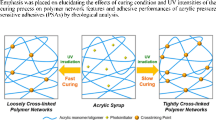Abstract
The effects of particle content, size and shape on the thermal conductivity (k) and adhesion properties of thermally conductive, pressure-sensitive adhesives (PSAs) were investigated. The matrix resins were thermally crosslinkable, 2-ethylhexyl acrylic polyol and ultraviolet (UV)-curable, random copolymer consisting of acrylic oligomer and various acrylates. We found thatk increased with increasing diameter and particle aspect ratio, and was further enhanced due to the reduction of the interfacial thermal barrier when the coupling agent, which increases the adhesion between particles and the matrix resin, was used. On the other hand, adhesion properties such as peel strength and tack of the thermally crosslinkable resin decreased sharply with increasing particle content. However, for UV curable resin, increased particle addition inhibited the decrease in adhesion properties.
Similar content being viewed by others
References
H. Ishida and S. Rimdusit,Thermochimica Acta,320, 177 (1998).
J. Bae, W. Kim, and S. Cho,J. Material Science,35, 5907 (2000).
Y. Xu, D. D. L. Chung, and C. Mroz,Composites: Part A,32, 1749 (2001).
P. Bujard, G.. Kuhnlein, S. Ino, and T. Shiobara,IEEE Transac. Compn. Packg. Manu. Tech: Part A,17, 527 (1994).
R. F. Hill and P. H. Supancic,J. Am. Ceram. Soc.,85, 851 (2002).
C. T. Murrary, R. L. Rudman, M. B. Sabade, and A. V. Pocius,MRS Bulletin,28, 449 (2003).
Japan Patent, 2000-290615A (Tokai Rubber Co., Japan).
Japan Patent 2005-97440A (Sumitio-3M Co., Japan).
J. W. Bae, W. Kim, S. Hwang, Y. S. Choe, and S. H. Lee,Macromol. Res.,12, 78 (2004).
D. W. Kang and H. G. Yeo,Polymer(Korea),29, 161 (2005).
C. P. Wong and R. S. Bollampally,J. Appl. Polym. Sci.,74, 3396 (1999).
C. P. Wong and R. S. Bollampally,IEEE Transac. Adv. Packg.,22, 54 (1999).
I. H. Tavman,Int. Comm. Heat Mass Transfer,25, 723 (1998).
Y. Nagai and G. Lai,J. Ceram. Soc. of Japan,105, 213 (1996).
Y. P. Mamunya, V. V. Davydenko, P. Pissis, and E. V. Lebedev,Eur. Polym. J.,38, 1887 (2002).
D. Kumlut, İ. H. Tavman, and M. T. Çoban,Composites Sci. Technol.,63, 113 (2003).
A. Boudenne, L. Ibos, M. Fois, J. C. Majesté, and E. Géhin,Composites: Part A,36, 1545 (2005).
S. E. Gustafsson,Rev. Sci. Instrum.,62, 797 (1991).
J. K. Kim, W. H. Kim, and D. H. Lee,Polymer,43, 5005 (2002).
Author information
Authors and Affiliations
Corresponding author
About this article
Cite this article
Kim, J.K., Kim, J.W., Kim, M.I. et al. Thermal conductivity and adhesion properties of thermally conductive pressure-sensitive adhesives. Macromol. Res. 14, 517–523 (2006). https://doi.org/10.1007/BF03218718
Received:
Revised:
Issue Date:
DOI: https://doi.org/10.1007/BF03218718




